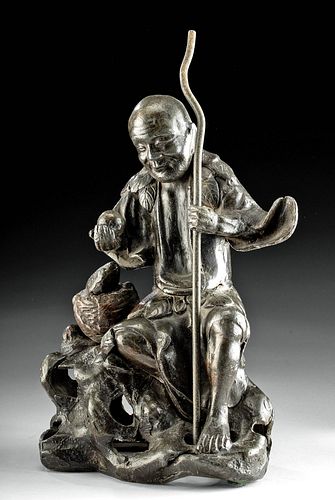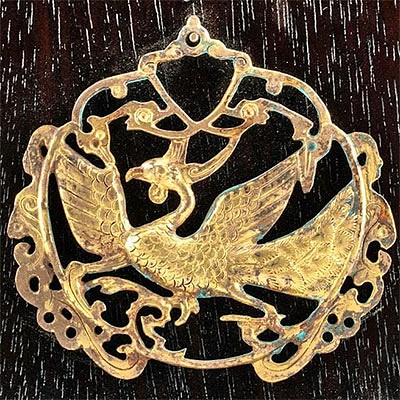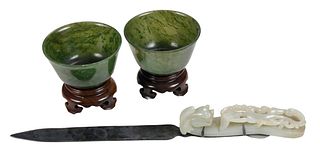18th C. Chinese Qing Seated Figure in Lead
Lot 111
About Seller
Artemis Gallery
686 S Taylor Ave, Ste 106
Louisville, CO 80027
United States
Selling antiquities, ancient and ethnographic art online since 1993, Artemis Gallery specializes in Classical Antiquities (Egyptian, Greek, Roman, Near Eastern), Asian, Pre-Columbian, African / Tribal / Oceanographic art. Our extensive inventory includes pottery, stone, metal, wood, glass and textil...Read more
Categories
Estimate:
$2,600 - $3,900
Absentee vs Live bid
Two ways to bid:
- Leave a max absentee bid and the platform will bid on your behalf up to your maximum bid during the live auction.
- Bid live during the auction and your bids will be submitted real-time to the auctioneer.
Bid Increments
| Price | Bid Increment |
|---|---|
| $0 | $25 |
| $300 | $50 |
| $1,000 | $100 |
| $2,000 | $250 |
| $5,000 | $500 |
| $10,000 | $1,000 |
| $20,000 | $2,500 |
| $50,000 | $5,000 |
| $100,000 | $10,000 |
| $200,000 | $20,000 |
About Auction
By Artemis Gallery
Jun 17, 2021
Set Reminder
2021-06-17 10:00:00
2021-06-17 10:00:00
America/New_York
Bidsquare
Bidsquare : Ancient & Ethnographic Art Through The Ages
https://www.bidsquare.com/auctions/artemis-gallery/ancient-ethnographic-art-through-the-ages-7094
Ancient art from Egypt, Greece, Italy and the Near East, as well as Asian, Fossils, Pre-Columbian, Native American, African / Tribal / Oceanic, Fine art, and much more! All categories, all price ranges... all legally acquired and guaranteed to be as described or your money back. Artemis Gallery info@artemisgallery.com
Ancient art from Egypt, Greece, Italy and the Near East, as well as Asian, Fossils, Pre-Columbian, Native American, African / Tribal / Oceanic, Fine art, and much more! All categories, all price ranges... all legally acquired and guaranteed to be as described or your money back. Artemis Gallery info@artemisgallery.com
- Lot Description
East Asia, China, Qing Dynasty, ca. late 18th to early 19th century CE. A charming hollow lead statue of an intricately detailed seated man next to a basket of fish expertly cast via the lost wax (cire perdue) process and presenting in a dark taupe hue. Holding a walking stick in his left hand as his flared sleeve gracefully blows in the wind, the sage-like figure looks down jovially at an orb-shaped object, perhaps an apple or another spherical fruit, held in his right hand. His round visage features a long wrinkled forehead, two heavy-lidded almond-shaped eyes adorned with crow's feet, a wide flat nose, prominent cheekbones, full lips fixed in a small grin flanked by dimples, and some heavy stubble, on its way to becoming a beard. His long straight hair falls onto the top of his back, as large leaves adorn his shoulders and his robe, which hangs open and exposes his chest, is tied at his waist with a string of additional sizable foliage. A small woven basket with the head of a fish poking out is placed to his right, implying that he has stopped for a meal. Size: 5.25" W x 8.875" H (13.3 cm x 22.5 cm)
His leafy outfit and basket of fish indicate that he may be Fuxi, the first male ancestor of Chinese mythology and inventor of fishing, hunting, cooking, writing, and the domestication of livestock. Though usually depicted with the body of a snake accompanied by his sister, Nuwa, he is sometimes shown as a lone sage-like man, such as in a woodcut entitled "The Emperor Fuxi" by Gan Bozong (Tang period 618 to 907) in the Wellcome Collection, London (ID number: L0039312).
Provenance: private Newport Beach, California, USA Collection
All items legal to buy/sell under U.S. Statute covering cultural patrimony Code 2600, CHAPTER 14, and are guaranteed to be as described or your money back.
A Certificate of Authenticity will accompany all winning bids.
We ship worldwide and handle all shipping in-house for your convenience.
#148620Walking stick is removable. Expected surface wear with some light scratches throughout, nicks/chips to edges of sleeves and left ear, and minor perforations on lap and back. Nice remains of red paint on lap of figure, seat, and basket. Otherwise, excellent with lovely patina.Condition
- Shipping Info
-
All shipping is handled in-house for your convenience. Your invoice from Artemis Gallery will include shipping calculation instructions. If in doubt, please inquire BEFORE bidding for estimated shipping costs for individual items.
-
- Buyer's Premium



 EUR
EUR CAD
CAD AUD
AUD GBP
GBP MXN
MXN HKD
HKD CNY
CNY MYR
MYR SEK
SEK SGD
SGD CHF
CHF THB
THB














